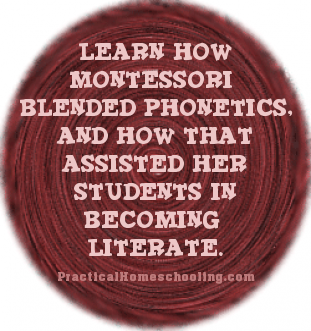Phonics the Montessori Way, Part 2 - Blending
By Kathy von Duyke
Printed in Practical Homeschooling #46, 2002.
 More on teaching reading with phonics the Montessori way, this time with blending!
More on teaching reading with phonics the Montessori way, this time with blending!

 More on teaching reading with phonics the Montessori way, this time with blending!
More on teaching reading with phonics the Montessori way, this time with blending!

|
 |
 Research has found that good readers know the letter sounds and know how to separate and blend the sounds in a word. The ability to hear and separate individual sounds within a word (phonemic awareness), and then to blend those sounds into a word, is basic to reading and spelling. Yet, this crucial skill is not often taught. Blending is mostly a developmental skill, meaning your child will not be able to do it until his brain has developed the connections needed, but you don't know when he will catch on, and in the meantime, as you model this crucial skill, you will continue to review the phonetic code.
Research has found that good readers know the letter sounds and know how to separate and blend the sounds in a word. The ability to hear and separate individual sounds within a word (phonemic awareness), and then to blend those sounds into a word, is basic to reading and spelling. Yet, this crucial skill is not often taught. Blending is mostly a developmental skill, meaning your child will not be able to do it until his brain has developed the connections needed, but you don't know when he will catch on, and in the meantime, as you model this crucial skill, you will continue to review the phonetic code.
1) Lay out the a, t, and m cards in front of your child. Ask your child to tell you the sound of the m card, then the a card, then the t card. Push the a over next to the m and say, "/mmmmaaaaaa/." Hold your throat and tell him to do the same so he can feel the vibration of his vocal cords as they sustain the sound. Tell him, "Keep the sound going."
2) The first two letters are the critical part of blending. Getting those two letters to mingle is actually changing their sound somewhat. Here is how you have set up the cards on your table:
m a t
Now push the t towards the ma and say, "Now we are going to ad this sound /t/. This word is /mmaat/." Sound the word slowly while running your finger from left to right under the cards. Invite your child to say it slowly with you. Then say, "Say it fast, /mat/." Give him a chance to copy you. Then say, "What word?" (pause) "/mat/." If your child actually answers the right word, be really excited, but don't think he can read now. He is just learning to follow your modeling. The hands-on activities will encourage him to read 3 letter words.
Here's a variation. Lay out the word mat. Say, "mat, how many sounds do you hear? Let's say them." Say, "/mmmm/, /aaaa/, /t/" Clap and say them again, then say, "three."
The Montessori approach, along with many other phonics programs teaches word "families." These include those patterns such as -at or -ed, where a series of consonants is added at the beginning to make sat, cat, hat, etc. In educational literature, these are called "onsets" and "rimes." This is a useful strategy to use when you're teaching spelling, because it reveals to children that words can be grouped by spelling patterns. But this doesn't work in teaching reading, because the child has to work backwards, remembering the /at/ then adding the consonant at the front end. This is far too difficult for a beginning reader. Besides, at shouldn't be memorized as a separate piece of code. The child already knows the code needed to decode at. It is very important that the child only memorizes what must be memorized so the mind has less basic information to cycle through when presented with a word.
Blending and story making practice. Create 3 piles of overturned cards. One pile should contain those letters that have a sustained sound. The second pile should be the vowels, and the third pile those consonants with a bursting sound. Let the child pick from each pile and try to read the word he created. Pick again to create another word. Make up a funny sentence with the words he created. Play with the words verbally. For instance, leg had could lead to, "Ouch! My leg had a bad cut!"
Blending level 2. The next blending developmental hurdle is the ability to read two consonants together and blend their sounds. Many phonics programs teach the blends as separate phonograms. Again, it appears as if the child has to memorize a whole new category of sounds, such as st-, cl-, tr- etc. But in fact, these are not new sounds at all but the same code blended together. Do not encourage your child to memorize these sounds, but do point out to him that many words have the same patterns of blends. Let him experiment with the sandpaper letters to make as many words as he can out of the same blends, but show him how the blends are just the two sounds pushed together.
Continue teaching following a cycle of presentation, absorption, hands-on experimentation and discovery, and presentation of the next sequential piece. The following activities are a short list of jobs you can make for your child to use to internalize the phonetic code.
Hands-on Activities
Sandpaper letters. Leave the sandpaper letters that have been introduced in a basket so that you child may trace and say the letters on his own.
Handwriting practice. Make or buy handwriting practice sheets. Leave several copies of each letter learned out. It is helpful to cut these sheets in half so they are less intimidating. This is best for children of four or older.
Free writing. Purchase a small 5-1/2 x 8" clipboard and load it with half sheets of paper. Tie a pencil to it and allow your child to "write" as he sees fit. Though you present proper letter formation via the sandpaper letters, he will need experimentation with paper and pencil as well both in formation and invented spelling.
Object drawers. Using the sorts of mini-drawers found in hardware stores to sort nails and screws or fishing tackle, write each letter presented on the front of its own drawer. Place inside objects that start with that sound. Use as many three-letter-word objects as you can. www.montessorieservices.com sells these one at a time, or as a package, complete with labels. Examples include ax, apple, bag, basket, bat, bee, bell, bib, etc.
Show your child how to open one drawer and lay out each object on a piece of felt, saying its name and emphasizing its initial sound.
Objects with 2 letters. Later, take out the contents of two or three drawers and place them in a basket with two or three cards of the letters represented. Show your child how to lay the cards out and place the objects underneath them according to their beginning sounds.
|
b |
c |
d |
| photos of: |
bib |
cat |
dog |
|
bee |
can |
drum |
Letter Sound and Name Bingo. After introducing several letters, begin to teach your child that letters have names. Practice these cards, first for sound and then for letter name. Use the letters you have learned and words you can make with them for your bingo board, or use the pages provided in Reading Reflex (available from amazon.com through www. readamerica.net).
Letter sequencing. After most of the alphabet has been presented, begin to teach the order of the alphabet. While singing is useful, that memory can only be accessed through song unless the information has also been processed in other ways. Provide an alphabet strip as a guide. Prepare a small section of the alphabet on a strip of card stock. Lay out three to five cards for the letters that have been left blank. Let your child fill in the missing letters.
Practice hearing ending and middle sounds. For this I recommend:
- MECS Software
- Consonant Snap!
- Pictures of object with 3 letter word label and individual letters to copy the label.
- 3- and 4-letter word building with red and blue letters
These items can be found in many of the Montessori catalogs available online.
Beginning Readers and Story
Once the child has mastered the basics of blending 3-letter words, he is ready for beginning readers that will begin to use those words within a story. Often, sight words are interspersed with the story. Children easily master these becasue they are motivated to read the story and real books.
Dr. Renee Fuller developed the Ball-Stick-Bird approach to beginning readers. From her research, she learned that the basic unit of the human's brain ability to organize thought and information is through the story engram. She has written that words should not be taught and drilled within lists, but learned from within stories. In articles on her web site, www.ballstickbird.com, she notes that teaching words by drilling leads to dyslexia and other mental mix-ups towards print.
The simplest form of story is a noun and a verb, which to the human mind is one byte or one "story engram," as Dr. Fuller labels it. Think of learning history through memorizing a series of dates and events, or through reading historical fiction. In which method to you most easily retain information? If that information is coupled to issues that are important to you, they are retained even better. And of course, if that information is acted out or acted on, the retention is highest. So, Dr. Fuller built her readers around the universal theme of good versus evil. Doing a major epic between good and evil with 3-letter words, mostly nouns and verbs, she came up with bad Voo-roos, a good guy named Vad, and an intergalactic battle field. One of my children was very slow to retain the letter sounds and every other aspect of reading, but he grabbed onto these readers with great interest and intent. The only problem I found was that they are all written in capital letters as Dr. Fuller felt this would spare the child from letter reversals. Since I had already taught my children through lowercase letters, I had to tape over and rewrite the initial stories until they caught on.
The main benefit of readers is that the second half of the phonetic code is presented within the context of stories, and the patterns in words are easily picked up by the child who is eager to move on. So /igh/ is figured out or presented in the word light, and then underlined in fight, and noticed again in might. The child begins to absorb and make sense of the pattern of our language.
At this level reading is picked up by visual patterns of code. To test your child on the code and teach areas he might have missed himself, Reading Reflex has a simple way for you to determine what your child needs to know.